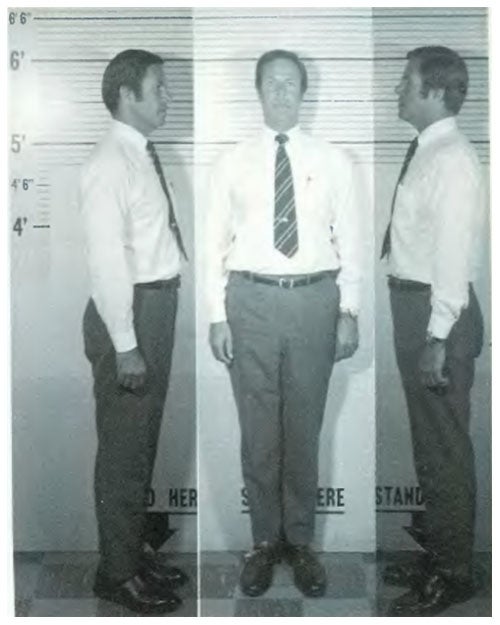
Nixon's Chief of Staff, H. R. Haldeman, mug shot, 1973
I have spent the last seven years studying Watergate with John Dean, Nixon’s White House Counsel. We present a continuing legal education program on the legacy of Watergate for lawyers. Our first program, called Watergate I, was a deep dive into obstruction of justice. The context for the three-hour program was the so-called “smoking gun” tape that spelled the end for Richard Nixon.
Before looking at obstruction of justice, let me review the facts about the “smoking gun” tape.
On Friday, June 23, 1972, Richard Nixon met with his chief of staff, H. R. Haldeman, in the Oval Office. The conversation was caught on tape, by means of a voice-activated system Nixon had had installed by the Secret Service. Few knew of the existence of the taping system. Both Haldeman and Nixon, though, knew they were being taped.
June 23 was almost exactly a week to the day after burglars had been caught breaking into the Watergate warren of offices that housed the Democratic National Committee. Nixon was vacationing at the time, but returned to the White House on Tuesday, June 20. He and his staff tried to piece together what had happened — because the Watergate operation originated out of the Committee to reelect the president, and the White House had only a vague understanding of what Gordon Liddy and Howard Hunt, the masterminds of the burglary, were up to.
One threat to the White House — Hunt had an office in the Executive Office Building and kept a safe there. Hunt had dropped off listening devices and other criminal evidence at the EOB the day after the break-in at and the FBI was asking questions (Hunt’s connections to the White House were reported in the “Washington Post.”) It is not clear that the grand jury had yet been impaneled to investigate the break-in. Hold that thought.
Nixon and his men were hoping to “cut them off at the pass,” as Nixon was fond of saying. On Thursday night, June 22, John Dean, White House Counsel, spoke with John Mitchell, Nixon’s former attorney general and the chair of the president’s reelection campaign. Mitchell told Dean of a “delimitation agreement” that existed between the CIA and the FBI. The gist: If one agency, through an investigation, was getting into sensitive sources or information that might expose the work of the other agency, the investigation would be curtailed.
But a request was needed to invoke the agreement.
Howard Hunt, a former White House plumber and a man who had left a trail of incriminating evidence (including checks in his Watergate hotel room), had worked for the CIA. Specifically, Hunt helped to organize Cubans in Miami to take part in the failed Bay of Pigs operation. Some of those same Cubans were the Watergate burglars. So, the argument went, if the FBI continued to investigate Watergate it might expose Howard Hunt and reopen wounds the CIA suffered as a result of the ignominy of the Bay of Pigs operation.
Mitchell’s idea was that the CIA could ask the FBI to limit its investigation. John Dean took this information and relayed it to Bob Haldeman, Nixon’s chief of staff, on Friday morning, June 23.
Haldeman took notes of the conversation with Dean and walked into the Oval Office to speak with the president at 10:04 a.m.
“Now on this investigation thing, you know, the Democratic break-in thing,” Haldeman started, “we’re back in the problem area because the FBI is not under control.”
Haldeman then proceeded to describe an investigation that was getting hot and an FBI leader, Pat Gray, who was a novice to the job (Hoover had just died the month before). Gray was struggling to limit the FBI investigation, and he needed help, according to Haldeman.
“Mitchell came up with yesterday, and John Dean has analyzed very carefully last night and concludes, concurs now with Mitchell’s recommendation that the only way to solve this, and we’re set up beautifully to do it, ah, in that the only network that paid any attention to it was NBC,” Haldeman continued, working his way into the suggestion about the delimitation agreement.
“The way to handle this now,” Haldeman said, “is for us to have Walters (Deputy Director of the CIA who had been appointed by Nixon) call Pat Gray (Acting Director of the FBI who Nixon had appointed) and just say, ‘Stay the hell out of this, ah, business here we don’t want you to go any further on it.’ That is not an unusual development.”
After some discussion, Nixon agreed. He rehearsed how the ask should proceed: “Of course, this is a , this is, ah, Hunt, you will, that will uncover a lot of, see, you open the [Bay of Pigs] scab and there’s a hell of a lot of things and we just feel that it would be very detrimental to have this thing go any further. This involves these Cubans, Hunt, and a lot of hanky-panky that we have nothing to do with ourselves.”
Vernon Walters of the CIA was summoned to the White House where he was given his instructions. He in turn contacted Acting Director Gray and told him the CIA might be involved and to limit the investigation. Gray did so for about a week, but then reengaged the FBI in a full investigation.
The tape of this conversation is called the “smoking gun” because when it was produced in late July 1974, after a long court battle ending in the Supreme Court ordering the tapes to be released, it showed that Nixon was abusing his power in trying to limit an FBI investigation. It also put the lie to Nixon’s line that he knew nothing about the cover-up until Dean told him about it in March 1973.
Two weeks after the tape became known, Nixon resigned rather than face impeachment.
But was this conversation, similar to Donald Trump’s direct conversation with FBI Director James Comey to limit the investigation into General Flynn, an obstruction of justice?
The general omnibus obstruction statute, 18 U.S.C. Section 1503, has the following elements: (1) there must be a pending federal judicial proceeding; (2) the defendant must know of the proceeding; and (3) the defendant must “corruptly interfere with or attempt to interfere” with the proceeding.
Note the critical requirement of a pending proceeding. Generally, the pendency of a grand jury investigation of an potential crime is sufficient. But a simple FBI investigation is not a “pending judicial proceeding.”
So the keys in the Watergate analysis were whether the grand jury investigating the break-in had been impaneled and was taking evidence, and whether Nixon and his people knew about its existence.
With President Trump, it appears that there was no grand jury yet impaneled to investigate General Flynn’s potential criminal activity when Trump asked Director Comey to go easy on Flynn.
But his actions form a continuing course of conduct. Later, when a grand jury had been impaneled and in fact had issued subpoenas just hours before Comey’s firing, it is arguable that Trump’s course of conduct leading up to that firing reveals a “corrupt intent,” which was being actively pursued when he fired Comey. The earlier conversations with Director Comey then become evidence of Mr. Trump’s intent to limit a judicial proceeding.
The firing for a corrupt purpose—to obstruct a pending judicial proceeding—would seem to fit the elements of the crime of obstruction of justice.
There are other obstruction statutes that can be referenced, including interfering with a Congressional investigation or a proceeding before a Department or Agency of the federal government, but it is generally conceded that an FBI investigation alone does not satisfy the requirement of a pending proceeding.
You need a grand jury generally speaking.
All of this is not to say that the crime of obstruction of justice needs to be proven to have an impeachment under the Constitution. Article 2, Section 4 requires treason, or “high Crimes and Misdemeanors,” a term that generally refers to abuses of office—that is, political matters. Thus, an obstruction of justice that doesn’t fall within the technical terms of the law can still be the basis for impeachment.
The first article of impeachment against Richard Nixon was that he used “the powers of his high office,” to engage in “a course of conduct or plan designed to delay, impede, and obstruct the investigation of such illegal entry; to cover up, conceal and protect those responsible; and to conceal the existence and scope of other unlawful covert activities.” There was no need to cite the obstruction of justice statute, as that was not the standard for impeachment.
Any way you look at it, President Trump’s actions, if Director Comey is to be believed, probably rise to the level of obstruction of justice when seen as a continuing course of conduct, and certainly fit the precedent set in the Nixon impeachment inquiry as “high Crimes and Misdemeanors.”
James Robenalt lectures with John Dean on Watergate and legal ethics. watergatecle.com. He is also the author of three books, the latest January 1973, Watergate, Roe v. Wade, Vietnam, and the Month That Changed America Forever. january1973.com. He is a contributing author to The Presidents and the Constitution, A Living History (New York University Press, Gormely, ed.)
